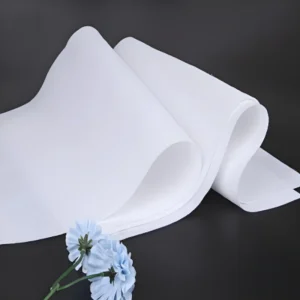Modern nonwoven materials have evolved from disposable sanitary products to core materials in the clothing, home furnishing, geotechnical, filtration, and automotive industries. Nonwoven fabrics do not go through weaving or knitting, skipping the yarn link, and directly make fibers or polymers into a fiber web, and then use mechanical, thermal, and chemical methods to reinforce it into cloth. The following uses a simple structure to help you quickly understand the process.
Nonwoven fabrics meaning
Nonwoven fabrics are a material that can be directly formed into a web and reinforced into cloth without spinning and weaving. It is made of fibers or filaments as raw materials, and is combined by mechanical, thermal, or chemical methods. It has the characteristics of lightness, breathability, and high functionality.

1. Basic process of nonwoven fabrics
Raw materials (fibers/polymers) → web → bonding → finishing/functionalization → rolling or cutting.
The raw materials can be made of polypropylene, polyester, viscose, cotton, recycled fibers, or functional fiber blends. Different processes determine the feel, strength, filtration efficiency, hygroscopicity, and cost.
2. Main web forming processes
Dry carding/needle punching bottom web: The fibers are loosened and carded into layers, and can be cross-laid to improve uniformity.
Needle-punched: The barbed needles puncture back and forth to mechanically entangle the fibers. It is a common process for clothing linings, home textile fillings, and geotextile nonwoven fabrics.
Spunlace / Hydroentangled: High-pressure water beam entanglement, soft cloth surface, common in medical wipes and cosmetic towels.
Spunbond: Polymer melt spinning, cooling and laying, thermal bonding, high strength, and large production capacity.
Meltblown: The melt is stretched into a microfiber layer through micropores + hot air flow, suitable for filtration and barrier.
SMS composite: Spunbond + Meltblown + Spunbond, multi-layer strength + filtration combination, medical protection, and heat protection.
3. Needle-Punched nonwoven fabric: Invisible support for clothing and home
The needle-punching process allows the fibers to be entangled vertically and horizontally, making the fabric difficult to delaminate, and the weight and thickness can be adjusted.
For clothing (Apparel / Interlining): Lightweight and breathable, it can be used as collars, plackets, sleeves, and waistband linings to enhance the structure without being bloated; sports and functional clothing can be stacked with moisture-absorbing, heat-insulating, or rebound layers.
Sleeve Wadding / Filling (Sleeve Wadding): Fixed thickness, flexible, and easy to cut.
Sustainable fashion: Recycled fibers and degradable formulas can be used to support circular clothing design.
4. Household & Engineering Needle-Punched nonwoven fabric
Home needle-punched nonwoven fabrics are widely used in sofas, mattresses, backrests, and armrest linings; high-weight versions can be used as furniture structure linings and spring isolation layers; enhanced rigid nonwoven fabrics can be used for headboards and box linings.
Similar needle punching systems are extended to geotextiles, filter linings, automotive interior base fabrics, and shoe midsole felts; changing the fiber type and quantity can match different strength and durability requirements.
5. Our nonwoven fabric products and customization capabilities
We are a professional nonwoven fabric manufacturer and export supplier, providing multi-process and multi-application solutions:
Needle‑Punched Nonwoven Fabric for Apparel / Interlining / Placket / Sleeve Wadding.
Household Needle Punched Non‑woven Fabric: sofa lining, furniture reinforcement, OEM home textile matching.
Functional nonwoven materials: geotextile, geomembrane matching lining, slope protection bag, and bentonite waterproof blanket base fabric.
Industry-specific: shoe materials, medical care, automotive interiors, filter media.
Customizable fiber system, gram weight, width, stiffness, flame retardant/waterproof/antibacterial, and degradable formulas; supports OEM labels and full cabinet exports.
Need nonwoven fabric samples or project-based supply? Welcome to contactar-nos directly!
6. Quick checklist for purchasing nonwoven fabric
Check the following parameters to greatly reduce communication time:
Process: needle punch / spunlace / spunbond / meltblown / SMS / other?
Application: clothing lining, furniture, geotechnical, filtration, medical?
Raw materials: PP / PET / viscose / blended fiber / recycled material / bio-based?
Weight & thickness range, width, and roll length.
Function: moisture absorption, heat insulation, flame retardant, environmentally friendly, and recyclable?
Certification: OEKO‑TEX, REACH, RoHS, medical grade, geotechnical specification?
Resumo
Nonwoven fabric skips yarn manufacturing with the “fiber web + consolidation” process, greatly saving processes and enabling modular performance; the combination of needle punch, spunbond, meltblown, spunlace, and other technologies allows it to expand from clothing accessories to home furnishings, filtration, medical care, geotechnical, and recycling materials. Choosing the right process and supplier often determines the product feel, structural life, and sustainable competitiveness.
Want to use nonwoven fabric as clothing lining, furniture reinforcement, or functional geotechnical materials? Welcome to contact us, we will provide customized solutions according to your formula, weight, and target market.





